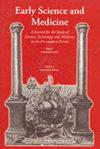近代早期如何从罗马向巴黎发送秘密信息:电报在磁力、同情和骗子之间
IF 0.2
2区 哲学
Q3 HISTORY & PHILOSOPHY OF SCIENCE
引用次数: 0
摘要
1558年,著名的自然魔术师詹巴蒂斯塔·德拉·波尔塔(Giambattista della Porta)第一个提到了一种通过操纵磁罗盘传递秘密信息的方法。此后不久,这个在现代史学中被称为“磁性电报”的想法,被许多早期现代学者阐述和宣传为一种有前途的远距离通信技术。1609年,丹尼尔·施文特(Daniel Schwenter)为实现这一潜力创造了最复杂的设计:将两根罗盘针以高度规范化的程序磁化,以在它们之间建立交感神经连接。在一个由字母限定的指南针中使用,当另一个针移动到同一个字母时,一个针就会转向某个字母。人们认为,通过“同情”,即使相隔数英里,也能发生这种情况。这个想法的第一个批评者,耶稣会士莱昂纳多·加尔佐尼,很快就把它斥为骗局,许多后来的作者认为,这个设备无法工作,因为两个设备之间没有这种“共鸣”或磁力。尽管这只是自然魔法的白日梦,但这种伪磁电报技术证明了早期现代学者的想象力,他们预言了即时全球通信的现代现实。本文章由计算机程序翻译,如有差异,请以英文原文为准。
How to Send a Secret Message from Rome to Paris in the Early Modern Period: Telegraphy between Magnetism, Sympathy, and Charlatanry
In 1558, the famous natural magician Giambattista della Porta was the first to allude to a method of transmitting secret messages by using manipulated magnetic compasses. Soon thereafter, this idea, known in modern historiography as ‘magnetic telegraphy’, was spelled out and advertised by many early modern scholars as a promising technology of communication by action at a distance. In 1609, Daniel Schwenter created the most sophisticated design for the fulfillment of this potential: two compass needles were to be magnetized in a highly codified procedure to establish a sympathetic bond between them. Used in a compass circumscribed by an alphabet, one needle would turn to a certain letter whenever the other needle was moved to that same letter. Through ‘sympathy’, it was thought that this could made to occur even over a distance of many miles. The idea’s first critic, the Jesuit, Leonardo Garzoni, was quick to dismiss it as charlatanry, and many later authors argued that the device could not work as there was no such ‘sympathy’ or magnetism between the two devices. Though only a fanciful pipe dream of natural magic, this pseudo-technology of a magnetic telegraph yet testifies to the imagination of early modern scholars in having prefigured the modern reality of instantaneous global communication.
求助全文
通过发布文献求助,成功后即可免费获取论文全文。
去求助
来源期刊

Early Science and Medicine
HISTORY & PHILOSOPHY OF SCIENCE-
CiteScore
0.50
自引率
0.00%
发文量
22
审稿时长
>12 weeks
期刊介绍:
Early Science and Medicine (ESM) is a peer-reviewed international journal dedicated to the history of science, medicine and technology from the earliest times through to the end of the eighteenth century. The need to treat in a single journal all aspects of scientific activity and thought to the eighteenth century is due to two factors: to the continued importance of ancient sources throughout the Middle Ages and the early modern period, and to the comparably low degree of specialization and the high degree of disciplinary interdependence characterizing the period before the professionalization of science.
 求助内容:
求助内容: 应助结果提醒方式:
应助结果提醒方式:


